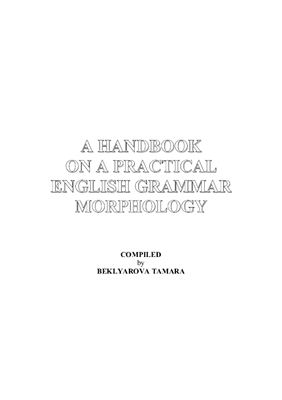Пособие по грамматике английского языка. – Ер.: Лингва, 2007. –
Yerevan, 2007. - 443 с.
Для Студентов русско-английских факультетов Лингвистических Университетов.
Contents
parts of speech in english
the verb
the morphological composition
Classifications of the Verb
The Finite Forms of the Verb
Tenses
the present tenses
the Simple Present Tense
The Present Continuous Tense
Verbs not normally used in the Continuous
tenses
The Present Perfect Tense
The Present Perfect Continuous Tense
The past tenses
the Simple Past Tense
The Past Continuous Tense
The Past Perfect Tense
The Past Perfect Continuous Tense
The future tenses
the Simple Future Tense
The Future Continuous Tense
The Future Perfect Tense
The Future Perfect Continuous Tense
Future-in-the-Past Tenses
Different Means of Expressing Future Actons
Voice
the Passive Voice
The sequence of tenses
the indirect speech
mood
the Indicative Mood
The Imperative Mood
The Oblique Moods
The Use of the Oblique Moods
The Conditional Mood
Subjunctive Ii
subjunctive I
the Suppositional Mood
The Forms of the Oblique Moods (Summary)
Modal Verbs
Can
May
Can and May Compared
Must
Must and May Compared
To Have to, Have got to
To Be to
Must, to Have to and to Be to Compared
Ought to
Shall and Should
Must, Should and Ought to Compared
Will and Would
Need
Dare
Shouldn’t + Perfect Infinitive, Oughn’t + Perfect
Infinitive, Needn’t + Perfect Infinitive Compared
Expressions of Absence of Necessity
Verbals (Non-finite Forms of the Verb)
The Infinitive
The Use of the Infinitive without the Particle
to (The Bare Infinitive)
Syntactical Functions of the Infinitive
Predicative Constructions with the Infinitive
The Objective with the Infinitive
Construction
The Subjective Infinitive Construction
The for-to-Infinitive Construction
THE GERUND
The Gerund and the Infinitve Compared
The Gerund and the Verbal Noun Compared
THE Participle
Participle I
Participle II
Predicative Constructions with the Participle
Participle I and the Gerund Compared
The article
The Indefinite Article
The Definite Article
Absence of the Article
The Use of Articles with Countable Nouns
General Rules for the Use of Articles with Countable
Nouns
Certain Peculiarities in the Use of the Definite Article
with Countable Nouns
The Generic Function of the Definite Article
The Use of Articles with Countable Nouns in Some
Syntactic Relations
The Use of Articles with Abstract Nouns
The Use of Articles with Uncountable Concrete Nouns
The Use of Articles with Some Semantic Groups of
Nouns
Certain Countable Nouns in Their Phraseological Use
The Use of Articles with Nouns Denoting Objects or
Notions Which are Considered to be Unique
The Use of Articles with Proper Names
The Place of Articles
Use of Articles with Nouns in some Set Expressions
THE nouns
The Gender of Nouns
The Number of Nouns
Notional agreement
The Case of Nouns
The adjective
the adverb
the pronoun
the numeral
bibliography
Для Студентов русско-английских факультетов Лингвистических Университетов.
Contents
parts of speech in english
the verb
the morphological composition
Classifications of the Verb
The Finite Forms of the Verb
Tenses
the present tenses
the Simple Present Tense
The Present Continuous Tense
Verbs not normally used in the Continuous
tenses
The Present Perfect Tense
The Present Perfect Continuous Tense
The past tenses
the Simple Past Tense
The Past Continuous Tense
The Past Perfect Tense
The Past Perfect Continuous Tense
The future tenses
the Simple Future Tense
The Future Continuous Tense
The Future Perfect Tense
The Future Perfect Continuous Tense
Future-in-the-Past Tenses
Different Means of Expressing Future Actons
Voice
the Passive Voice
The sequence of tenses
the indirect speech
mood
the Indicative Mood
The Imperative Mood
The Oblique Moods
The Use of the Oblique Moods
The Conditional Mood
Subjunctive Ii
subjunctive I
the Suppositional Mood
The Forms of the Oblique Moods (Summary)
Modal Verbs
Can
May
Can and May Compared
Must
Must and May Compared
To Have to, Have got to
To Be to
Must, to Have to and to Be to Compared
Ought to
Shall and Should
Must, Should and Ought to Compared
Will and Would
Need
Dare
Shouldn’t + Perfect Infinitive, Oughn’t + Perfect
Infinitive, Needn’t + Perfect Infinitive Compared
Expressions of Absence of Necessity
Verbals (Non-finite Forms of the Verb)
The Infinitive
The Use of the Infinitive without the Particle
to (The Bare Infinitive)
Syntactical Functions of the Infinitive
Predicative Constructions with the Infinitive
The Objective with the Infinitive
Construction
The Subjective Infinitive Construction
The for-to-Infinitive Construction
THE GERUND
The Gerund and the Infinitve Compared
The Gerund and the Verbal Noun Compared
THE Participle
Participle I
Participle II
Predicative Constructions with the Participle
Participle I and the Gerund Compared
The article
The Indefinite Article
The Definite Article
Absence of the Article
The Use of Articles with Countable Nouns
General Rules for the Use of Articles with Countable
Nouns
Certain Peculiarities in the Use of the Definite Article
with Countable Nouns
The Generic Function of the Definite Article
The Use of Articles with Countable Nouns in Some
Syntactic Relations
The Use of Articles with Abstract Nouns
The Use of Articles with Uncountable Concrete Nouns
The Use of Articles with Some Semantic Groups of
Nouns
Certain Countable Nouns in Their Phraseological Use
The Use of Articles with Nouns Denoting Objects or
Notions Which are Considered to be Unique
The Use of Articles with Proper Names
The Place of Articles
Use of Articles with Nouns in some Set Expressions
THE nouns
The Gender of Nouns
The Number of Nouns
Notional agreement
The Case of Nouns
The adjective
the adverb
the pronoun
the numeral
bibliography

